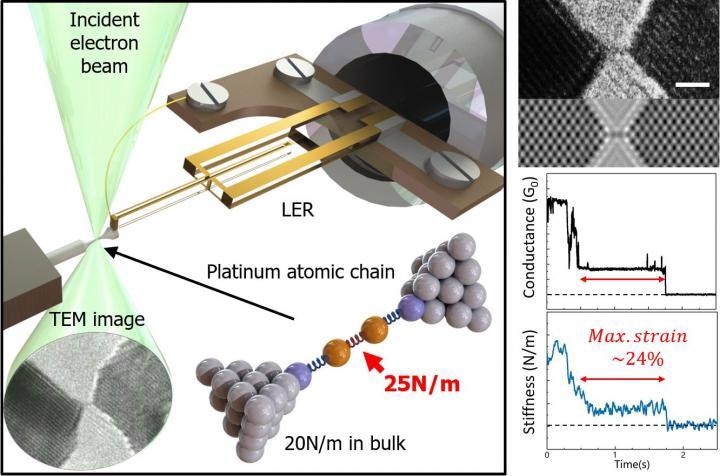May 17 2021
Nowadays, several well-studied materials in numerous fields like catalysis and electronics are in the vicinity of reaching their practical limits.
 (left) Schematic illustration of the technique. The stiffness of nanomaterials such as platinum (Pt) atomic chains can be measured using a length-extension resonator (LER) made with a quartz crystal. The atomic structure of the chain can be observed using a transmission electron microscope (TEM). We found that the atomic bond strength in the Pt monoatomic chains is 25 N/m, which is higher than the bulk value (20 N/m). (right) Experimental and simulated TEM images of a monoatomic Pt chain and time evolution of its electrical conductance and stiffness during stretching. The maximum strain was 24% on average. Image Credit: Yoshifumi Oshima.
(left) Schematic illustration of the technique. The stiffness of nanomaterials such as platinum (Pt) atomic chains can be measured using a length-extension resonator (LER) made with a quartz crystal. The atomic structure of the chain can be observed using a transmission electron microscope (TEM). We found that the atomic bond strength in the Pt monoatomic chains is 25 N/m, which is higher than the bulk value (20 N/m). (right) Experimental and simulated TEM images of a monoatomic Pt chain and time evolution of its electrical conductance and stiffness during stretching. The maximum strain was 24% on average. Image Credit: Yoshifumi Oshima.
Scientists are in the search of new functional materials have to push the boundaries and examine more extreme instances to enhance modern technology further and outclass advanced devices. An obvious example of this is the analysis of low-dimensional materials, like monoatomic chains (1D materials) and monoatomic layers (2D materials).
It has been demonstrated repeatedly that low-dimensional materials display exotic properties that their 3D bulk counterparts lack. For instance, monoatomic chains of metals such as platinum (Pt) and gold can show the contribution of specific quantum phenomena, like thermal transport or magnetic order, in ways that could help determine practical applications.
But it is really hard to experimentally visualize what happens in monoatomic chains consisting of five atoms or less, and the mechanical properties of single-atom bonds tend to stay elusive.
To handle this problem, a group of researchers under the guidance of Professor Yoshifumi Oshima from Japan Advanced Institute of Science and Technology (JAIST) has been mastering an innovative and potential method to quantify the strength of individual atomic bonds.
The new study, which was reported in the Nano Letters journal and demonstrated their approach, involved scientists from JAIST (Dr Zhang, Dr Ishizuka, Professor Tomitori, Professor Maezono, and Professor Hongo), as well as Professor Arai from Kanazawa University and Professor Tosatti from the International School for Advanced Studies (SISSA) and The Abdus Salam International Centre for Theoretical Physics (ICTP).
The latest method, which Oshima called the “microscopic nanomechanics measurement method,” integrates transmission electron microscopy (TEM) and a quartz length-extension resonator (LER).
TEM is an extensively utilized imaging technique with an unbelievably high spatial resolution that is sufficient to observe individual atoms—while the LER is a device with the ability to oscillate at extremely small amplitudes of a few ten trillionths of a meter and acts as a force sensor.
An experimental setup was devised by the scientists in which a small Pt juncture was extended to its absolute breaking point, namely, when the two pieces of Pt were connected by a monoatomic chain of two to five atoms.
By making cautious alignment of the pieces in the TEM, the researchers noted the development and breaking of the monoatomic Pt chains in real time. Furthermore, using the quartz LER, they quantified the conductance throughout the chain and its hardness, from which the power of separate Pt bonds was evaluated with success.
We found the bond strength of 25 N/m in the monoatomic Pt chains to be remarkably high, especially compared to the 20 N/m normally found in bulk Pt crystals. Moreover, these single-atom bonds could be stretched about 24% of their regular distance, in stark contrast to the 5% that bonds between Pt atoms in bulk can be stretched.
Dr Jiaqi Zhang, Japan Advanced Institute of Science and Technology
The study findings show the ability of this novel method to probe monoatomic chain bonds, which could result in better insights into the surfaces or interfaces of low-dimensional materials.
Our method could greatly contribute to the design of advanced materials and catalysts as well as shed light on nanoscale phenomena in terms of surface or interface nanomechanics.
Yoshifumi Oshima, Professor, Japan Advanced Institute of Science and Technology
On the other hand, highly advanced materials and increased knowledge of their surface properties will certainly help advance the fields of nanotechnology, chemistry, and electronics, thereby opening the door for novel and probably lasting designs.
It is highly probable that the expression “hanging by a thread” will get a more positive meaning in nanomaterials science, soon.
This work was financially supported by JSPS KAKENHI (grant nos. 18H01825 and 18H03879). The computations in this work were executed by using the facilities of the Research Center for Advanced Computing Infrastructure at JAIST.
Jiaqi Zhang was financially supported by the Sasakawa Scientific Research Grant from The Japan Science Society and the Exchange Research Grant Project from Marubun Research Promotion Foundation. Erio Tosatti acknowledges support by ERC ULTRADISS Contract No. 834402, and the Italian Ministry of University and Research through PRIN UTFROM N. 20178PZCB5.
Journal Reference:
Zhang, J., et al. (2021) Peculiar Atomic Bond Nature in Platinum Monatomic Chains. Nano Letters. doi.org/10.1021/acs.nanolett.1c00564.